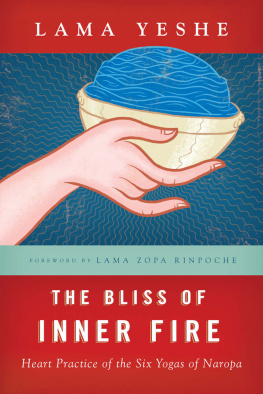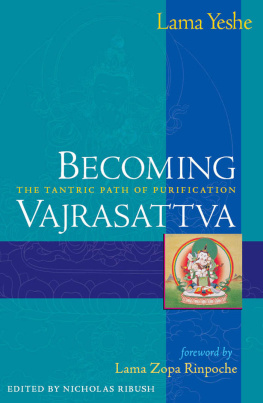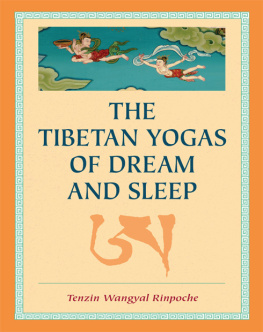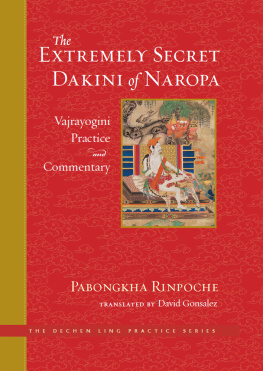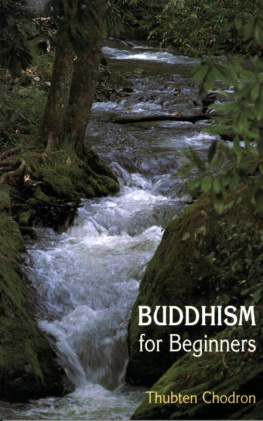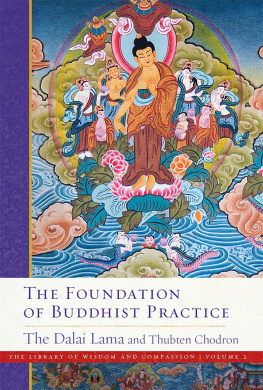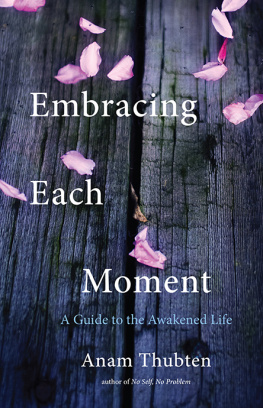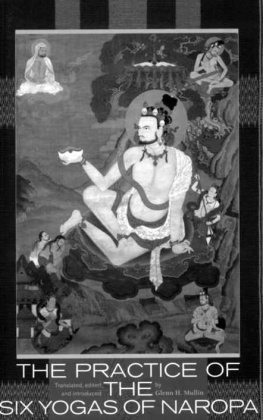Thubten Yeshe - The Bliss of Inner Fire: Heart Practice of the Six Yogas of Naropa
Here you can read online Thubten Yeshe - The Bliss of Inner Fire: Heart Practice of the Six Yogas of Naropa full text of the book (entire story) in english for free. Download pdf and epub, get meaning, cover and reviews about this ebook. year: 2005, publisher: Wisdom Publications, genre: Religion. Description of the work, (preface) as well as reviews are available. Best literature library LitArk.com created for fans of good reading and offers a wide selection of genres:
Romance novel
Science fiction
Adventure
Detective
Science
History
Home and family
Prose
Art
Politics
Computer
Non-fiction
Religion
Business
Children
Humor
Choose a favorite category and find really read worthwhile books. Enjoy immersion in the world of imagination, feel the emotions of the characters or learn something new for yourself, make an fascinating discovery.
- Book:The Bliss of Inner Fire: Heart Practice of the Six Yogas of Naropa
- Author:
- Publisher:Wisdom Publications
- Genre:
- Year:2005
- Rating:5 / 5
- Favourites:Add to favourites
- Your mark:
- 100
- 1
- 2
- 3
- 4
- 5
The Bliss of Inner Fire: Heart Practice of the Six Yogas of Naropa: summary, description and annotation
We offer to read an annotation, description, summary or preface (depends on what the author of the book "The Bliss of Inner Fire: Heart Practice of the Six Yogas of Naropa" wrote himself). If you haven't found the necessary information about the book — write in the comments, we will try to find it.
Thubten Yeshe: author's other books
Who wrote The Bliss of Inner Fire: Heart Practice of the Six Yogas of Naropa? Find out the surname, the name of the author of the book and a list of all author's works by series.
The Bliss of Inner Fire: Heart Practice of the Six Yogas of Naropa — read online for free the complete book (whole text) full work
Below is the text of the book, divided by pages. System saving the place of the last page read, allows you to conveniently read the book "The Bliss of Inner Fire: Heart Practice of the Six Yogas of Naropa" online for free, without having to search again every time where you left off. Put a bookmark, and you can go to the page where you finished reading at any time.
Font size:
Interval:
Bookmark:


A CONCISE YET DETAILED EXPERIENTIAL TEACHING. IF YOU HAVE STUDIED SOME SUTRA AND TANTRA, THEN YOU WILL THOROUGHLY ENJOY LAMA YESHE BRINGING THEM TO LIFE.
TIBET JOURNAL
In The Bliss of Inner Fire, his last major teaching, Lama Yeshe opens up the world of advanced practices for Highest Yoga Tantra initiates.
Lama Yeshe introduces the renowned Six Yogas of Naropa, focusing mainly on the first of these six, the practice of inner fire (tummo), following Je Tsongkhapas (13571419) text Having the Three Convictions. Mastery of inner fire quickly brings the mind to its most refined and penetrating state the experience of clear light, an extraordinarily powerful state of mind that is unequaled in its ability to directly realize ultimate reality.
An impressive contribution to the growing body of Buddhist literature for an English-reading audience.
THE MIDWEST BOOK REVIEW
The Bliss of Inner Fire is one of Wisdoms best.
THE REVIEW OF ARTS, LITERATURE, PHILOSOPHY, AND THE HUMANITIES
Lama Yeshe has given us a body of teaching of immense significance for practitioners of all schools of Buddhadharma.
LARRY ROSENBERG, AUTHOR OF BREATH BY BREATH

LAMA THUBTEN YESHE (193584) was born in Tibet and educated at the great Sera Monastic University. In the late 1960s he began teaching Buddhism to Westerners at Kopan Monastery, Kathmandu, Nepal, with Lama Zopa Rinpoche. In 1975 they founded the international Buddhist organization the Foundation for the Preservation of the Mahayana Tradition (FPMT), which now has more than 160 centers, projects, and services worldwide. His other books include Introduction to Tantra, Becoming Vajrasattva, Becoming the Compassion Buddha, Wisdom Energy, and When the Chocolate Runs Out.
Contents
Foreword
By Lama Thubten Zopa Rinpoche
T he unimaginable secret qualities and actions of a Buddha are the objects of knowledge only of the omniscient minds of other Buddhas. Therefore, there is no way that ordinary beings could understand Lama Yeshes secret qualities; they could only see his qualities in accordance with the level of their mind. However, since individual experience is one of the most effective ways of realizing that the essence of the guru is Buddha, I would like to remember again the wonderful qualities of Lama Yeshe that I did have the karma to see.

 THE QUALITIES OF LAMAS HOLY BODY
THE QUALITIES OF LAMAS HOLY BODY
Even people who had never met Lama Yeshe got a very warm feeling simply from seeing a photograph of him; they immediately felt he was someone who was very kind and concerned about others. I once sent an English pen friend, Audrey Cohen, a photo of Lama in a group of monks. Although I didnt explain which of the monks was Lama, Audrey wrote to say that she got a good feeling from seeing a particular monk in the back row; this monk was Lama.
Many people reacted in a similar way to seeing Lamas holy body. Even though many Tibetans did not know who Lama Yeshe was and had not heard of his background as a great scholar, simply seeing Lama made them very happy, and they often felt devotion arise towards him. Once when we were visiting Bodhgaya some Tibetans from Sikkim met Lama in the street and immediately sensed a holy purity in him; they felt that he must be a great bodhisattva. The meeting had such a strong impact on them that they asked some nearby monks who Lama was, but no one really knew. That same evening one of the Tibetans came to see me and explained how impressed they had all been by meeting Lama in the street. He had incredible faith that Lama was a great holy being.
Simply seeing Lamas holy body brought peace and joy to the mind, and a wish to see more of him. Even without being introduced to him, people naturally respected Lama. Even people who had not met the Dharma felt that Lama was different from ordinary people. When they met Lama, they sensed very particular qualities of purity and holiness; they felt not only that he was learned but also that he had a deep spiritual quality.
In the general view, Lamas physical aspect changed with the development of his mind. For several years before he passed away, he looked very light and very radiant. This was an expression of his tantric realizations. Those who were aware of the signs could recognize the outer changes that were evidence of his inner development, especially of completion stage tantric realizations.
Even when Lama was showing the aspect of serious illness, he would suddenly look so bright and magnificent that you could almost think that he had no sickness at all. Out of his great compassion, Lama manifested various aspects as needed to subdue different sentient beings.

 THE QUALITIES OF LAMAS HOLY SPEECH
THE QUALITIES OF LAMAS HOLY SPEECH
Lamas holy speech was like nectar, and its power is the personal experience of those who received teachings from him. Every single word came out of his bodhicitta; every single word was for others.
When other Tibetan lamas give a public talk in the West, where there are usually people who are completely new to the Dharma, they often speak on subjects with which they are familiar rather than on subjects the people in the audience need to hear. Lama, however, would not usually talk on any one fixed subject but would address the various problems, spiritual and mundane, of the people in his audience.
Like offering a smorgasbord, Lama would speak on one subject, then switch to another, then another, without there necessarily being a connection between the subjects. Even though they might not like all the foods served, everybody would find something they liked among the various dishes. No matter what their social class or level of education, everybody received an answer to their problems that suited the nature of their mind. Even though they might have arrived with confused minds, they returned home extremely happy and satisfied. After an hours talk from Lama, no one could walk away saying that they hadnt found the solution to their problems. This amazing skill is proof that Lamas holy action of teaching was Buddhas action.
It might appear to some people that Lama was simply telling many jokes to make people laugh, but those with a Dharma background appreciated how practical Lamas talks were. Someone who had been following Buddhadharma for twenty years and had heard many secret, profound teachings still found Lamas talks practical and beneficial. Lamas advice was not pie in the sky; it could be related to everyday life.
Some people came to Lamas lectures out of curiosity, just to see what a Tibetan lama looked like; they had no particular wish to receive teachings from a Tibetan lama or to study Buddhas teachings. Others came sincerely seeking peace of mind and some solution to the problems in their lives. From Lamas external appearance, they probably didnt expect him to have any methods to solve their problems. However, the more they listened to Lama, the more peaceful their minds became and the more they appreciated Lamas special qualities. Even someone with a mountain of pride in their own knowledge, which no one else could crush, would have their pride subdued by hearing Lama talk. They would naturally become more humble as a result of the teaching. At the same time, Lama himself had incredible humility, the quality of a learned person.
Next pageFont size:
Interval:
Bookmark:
Similar books «The Bliss of Inner Fire: Heart Practice of the Six Yogas of Naropa»
Look at similar books to The Bliss of Inner Fire: Heart Practice of the Six Yogas of Naropa. We have selected literature similar in name and meaning in the hope of providing readers with more options to find new, interesting, not yet read works.
Discussion, reviews of the book The Bliss of Inner Fire: Heart Practice of the Six Yogas of Naropa and just readers' own opinions. Leave your comments, write what you think about the work, its meaning or the main characters. Specify what exactly you liked and what you didn't like, and why you think so.

